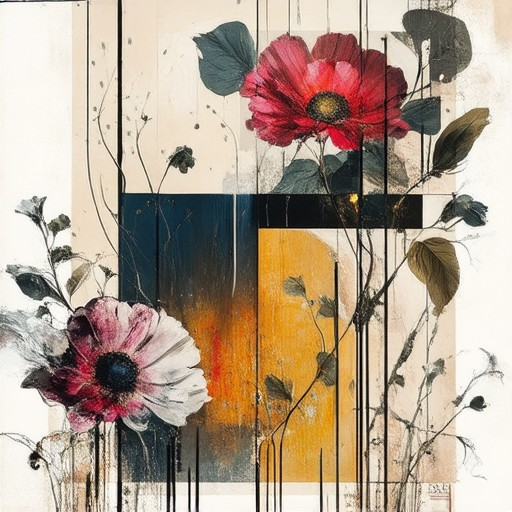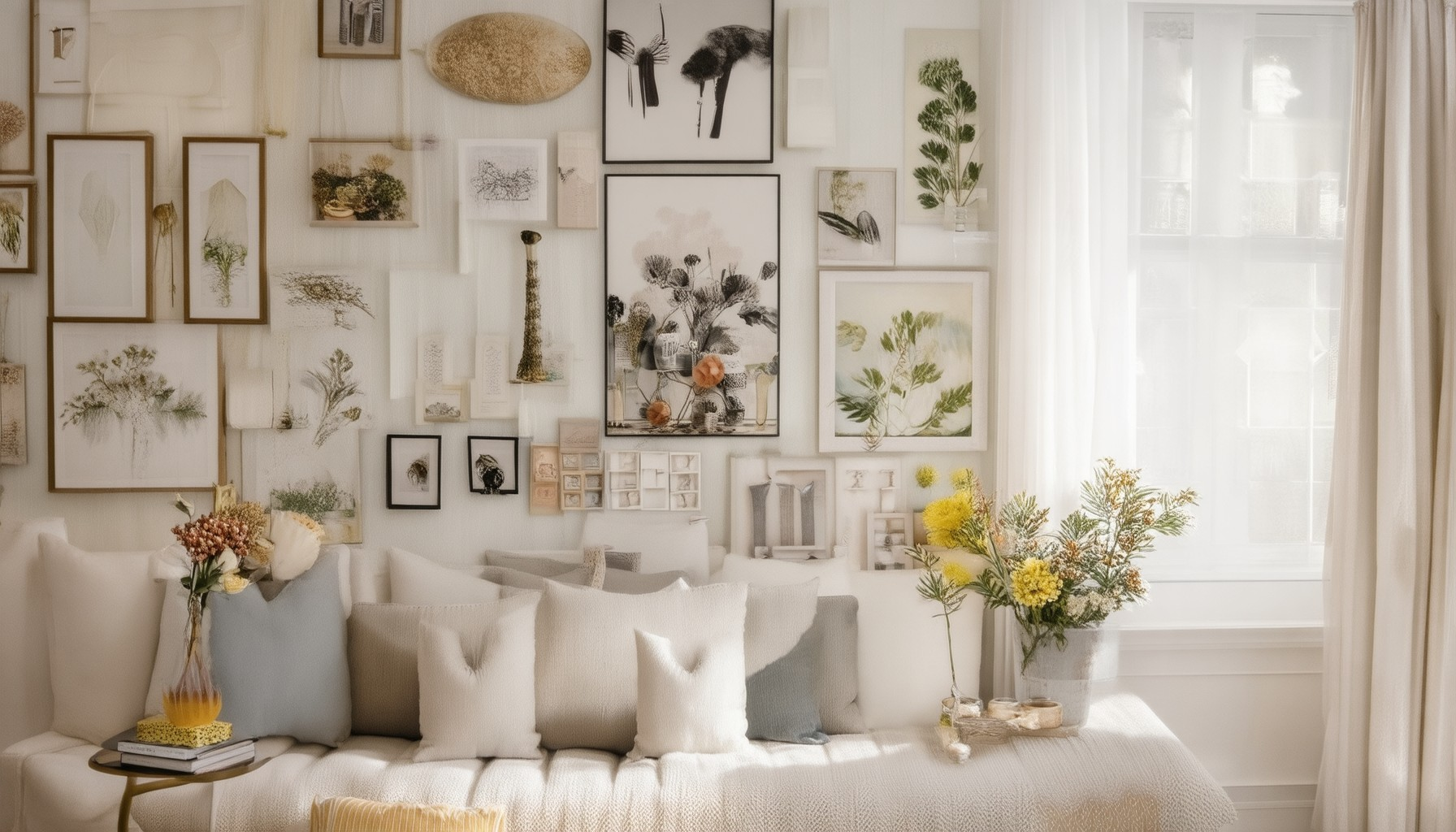Transform your space into a personalized masterpiece with DIY wall art ideas that are both affordable and endlessly customizable. Whether you’re aiming to refresh a room, add a unique touch to your home, or simply save money on decor, DIY wall art offers a versatile solution for every style and budget. From simple canvas paintings to intricate stencils and spray paint effects, there’s a DIY project here for everyone. Discover how to elevate your walls with ease, explore creative techniques, and learn expert tips to ensure your DIY wall art looks professional and stands the test of time. This guide covers everything you need to know, from the basics of getting started to designing stunning pieces that complement your decor. Get ready to unlock your creative potential and transform your walls into works of art!
Key Takeaways
– Enhance Your Space with Balanced Wall Decor: Achieve a clutter-free look by balancing wall decor to occupy two-thirds of the wall space, ensuring consistency, symmetry, and functionality.
– Master DIY Wall Art Placement: Hang artwork at standard heights (57-60 inches) with proper spacing (at least 2 inches apart) and consider grouping for a cohesive display.
– Choose the Right Wall Decor Types: Select from framed art, canvas prints, photograms, or mirrors to suit your style and needs.
– Coordinate Styles for Cohesive Design: Align your decor with your room’s color scheme and furniture for a harmonious aesthetic.
– Use Lighting and Seasons Wisely: Highlight your decor with lighting and update seasonsally for a fresh look.
– Prioritize Safety with the 2 Wall Rule: Identify safe rooms at least two walls away from the exterior for emergency shelter.
– Divide Spaces into Three Zones: Create functional areas for eating, working, and relaxing with tailored design suggestions.

Understanding the 2/3 Rule for Wall Art
The 2/3 rule is a popular guideline for determining the appropriate size and placement of wall art. According to this rule, a piece of artwork should be hung such that its width is two-thirds of the width of the space above it. This ensures that the artwork fits proportionally without overwhelming the space.
How to Apply the 2/3 Rule
To apply the 2/3 rule effectively:
- Measure the width of the space above the intended location (e.g., above a bed, bathtub, or fireplace).
- Determine two-thirds of this width by multiplying the measurement by 0.6667 or approximately 66.67%.
- Use this two-thirds measurement as the maximum width for your artwork.
Examples of Spaces
The 2/3 rule works well for various spaces, but adjustments may be needed based on the room’s layout and aesthetic preferences:
- Beds: Above a bed, the rule suggests the artwork should be no wider than two-thirds of the bed’s width. This creates a balanced look without clutter.
- Bathtubs: Above a bathtub, the artwork should align similarly, ensuring it complements the space without appearing too large.
- Fireplaces: Above a fireplace, the rule helps maintain symmetry and proportionality.
Practical Tips for Hanging Artwork
For the best results, follow these steps:
- Measure First: Use a tape measure to determine the width of the space above where you plan to hang the artwork.
- Mark the Position: Find the two-thirds mark on the wall to ensure proper alignment.
- Use the Right Tools: Install picture hooks and nails securely into the wall to support the artwork’s weight.
Conclusion
By applying the 2/3 rule thoughtfully, you can enhance your home decor with well-proportioned wall art that complements your space. For more tips and insights, visit Peck and Gartner to explore DIY projects and design inspiration.
How to Decorate Walls Cheaply?
Decorating walls doesn’t have to be expensive. Here are some creative and affordable ways to enhance your space:
- 1. Use Removable Wallpaper
- Apply peel-and-stick removable wallpaper for a quick refresh without damaging the walls.
- Choose patterns or textures that match your room decor.
- Clean and smooth the wall surface before applying.
- 2. Paint Accent Walls
- Paint one wall in a contrasting color to add drama and visual interest.
- Choose a color that complements your existing decor.
- Use flat paint or eggshell finish for a smooth look.
- 3. Add Wall Decals and Stickers
- Apply vinyl wall decals or stickers for a temporary update.
- Select designs that align with your style preferences.
- Remove them when needed without damaging the wall.
- 4. Install Affordable Shelving
- Add open shelving units to display books, decor, or photos.
- Use basic shelf brackets to mount the shelves securely.
- Paint the shelves to match your room color scheme.
- 5. Incorporate Textured Paint
- Apply textured wall treatments for added dimension.
- Choose from options like sandstone or wood grain effects.
- Combine with bold wall art for maximum impact.
For more ideas and tools, visit our home improvement guide to find budget-friendly solutions and expert tips.

What to Put on a Wall Instead of Pictures
Looking for creative alternatives to traditional framed artwork? Here are some unique ideas to decorate your walls:
- Quotes or Sayings: Display meaningful quotes, motivational phrases, or famous lines in bold, elegant fonts. You can use metal signs, wood panels, or even chalkboard paint for a personalized touch.
- Decorative Tiles: Add a pop of color or pattern with decorative tiles arranged in a mosaic-like fashion. These can be placed in clusters for a visually striking effect.
- Large Clocks: Turn a wall into a functional piece of art with a large, statement clock. You can even customize it using reclaimed wood or metal for added character.
- Wall-Mounted Mirrors: Create a focal point with a large mirror frame adorned with beads, crystals, or geometric shapes. Mirrors also reflect light, making the space feel larger.
- Textured Wall Panels: Install removable wall panels in different textures, such as sandstone or wood grain, to add dimension and visual interest to your space.
- Art Deco-Inspired Pieces: Opt for geometric shapes, vibrant colors, and metallic accents to mimic the elegance of Art Deco designs. These can be applied as wall sculptures or murals.
- Custom Decals: Use removable vinyl decals to display your favorite travel destinations, abstract art, or seasonal motifs. These are perfect for renters who want to switch things up frequently.
- Hanging Planters: Add a green touch to your walls with hanging planters. Not only do they add life to the space, but they also help purify the air and reduce stress.
- Stenciled Patterns: Use stencils to create temporary wall art featuring geometric patterns, floral designs, or abstract motifs. These can be easily changed to match your mood or decor style.
- Lightbox Installations: Transform a simple box into a glowing art piece by installing an LED lightbox. These can be customized with your name, initials, or favorite symbols.
- Ceramic Tile Murals: Create a colorful mural using ceramic tiles in various sizes and shapes. This adds texture and vibrancy to the wall while serving as a conversation starter.
Tips for Mixing and Matching:
- Mix smooth textures with rough finishes for contrast.
- Combine different materials like wood, metal, and resin for a layered look.
- Add lighting elements like string lights or subtle spotlights to highlight your wall features.

Rule of Wall Decor
The rule of wall decor is a simple yet effective guideline to enhance your space while avoiding clutter. Here’s how to apply it:
Key Principles
- 2/3 Rule:** As a general guide, your wall decor should occupy approximately two-thirds of the available wall space in a room. This ensures your walls feel balanced and less cluttered.
- Consistency:** Use uniform sizes and styles of wall decor to create a cohesive look. Mixing mismatched frames or decor can disrupt the visual balance.
- Symmetry:** Arrange your wall decor symmetrically, whether centered around a focal point or evenly distributed across the wall.
- Functionality:** Consider the purpose of the room. For example, place decorative pieces in high-traffic areas, while functional items like clocks or mirrors can go anywhere.
Placement and Spacing
- Standard Height:** Most wall art is hung between 57 inches (for ceiling height) and 60 inches (for floor height), leaving enough clearance for doorways and furniture.
- Spacing Between Frames:** Allow at least 2 inches of space between frames to prevent them from appearing cramped. For a gallery wall, aim for consistent spacing between each piece.
- Centering or Grouping:** Decide whether to center individual pieces or group them together. A trio of smaller frames often looks better than a lone large piece.
Types of Wall Decor
- Framed Art:** Classic choice for a polished look. Choose frames that complement your decor style.
- Canvas Prints:** Great for bold statements. Opt for larger sizes to make a bigger impact.
- Photograms or Quotes:** Add personality with meaningful words or images. These work well in smaller frames.
- Mirror or Clocks:** Functional decor that also serves a purpose. Place them strategically to reflect light and add interest.
Design Tips
- Coordinate with Room Style:** Ensure your wall decor matches your room’s color scheme, furniture style, and overall aesthetic.
- Layer with Lighting:** Use wall sconces or picture lights to highlight your decor and create ambiance.
- Update Seasonally:** Rotate or change your wall decor to match the season or your mood.
By following these rules, you can create a visually appealing and balanced wall display that enhances your space without overwhelming it. Remember to link to our wall decor guide for more tips and inspiration!
What is the 2 Wall Rule?
The 2 Wall Rule refers to a safety guideline during emergencies, particularly earthquakes or structural collapses. It suggests finding shelter in a room that is located at least two walls away from the exterior of the building. This ensures maximum protection against debris and structural failure.
Why Two Walls?
The principle is rooted in the idea that modern buildings are constructed with multiple layers of walls and structural components. In the event of a collapse, the outermost wall may collapse, leaving the inner wall to provide a safer refuge. This double-layered defense significantly reduces the risk of injury from flying debris or falling materials.
Steps to Apply the Rule
- Identify a room that is centrally located within your residence.
- Check if the room has at least two solid walls separating it from the exterior.
- Use this room as your safest haven during an emergency.
Rooms to Consider
- Pantry
- Interior closet
- Any room with deep structural integrity
By adhering to the 2 Wall Rule, you enhance your chances of survival in critical situations. Always prioritize finding shelter quickly and safely during emergencies.
For more expert insights and safety tips, visit our home improvement guide .

The Rule of 3 in Decorating
The “Rule of 3” in interior design refers to the principle that a well-decorated room can be effectively divided into three distinct zones or areas, each serving a unique purpose. This approach ensures functionality, comfort, and aesthetic appeal.
-
Eating Area
Designate a dedicated space for meals. This could include a dining table, chairs, and lighting that creates a welcoming atmosphere. Opt for soft, warm colors and comfortable seating to enhance the ambiance.
-
Working Area
Allocate a separate area for work or study. This should be a quiet, organized space with a desk, task lighting, and storage solutions. Neutral tones or calming colors can reduce stress and increase productivity.
-
Relaxing Area
Reserve a corner or section for relaxation, such as a cozy reading nook or a place for unwinding. Use plush furniture, soft lighting, and calming decor to create a retreat-like feel.
This rule of thumb helps create a balanced and multi-functional living space, catering to different activities while maintaining a cohesive design.
Conclusion
By applying the Rule of 3, you can transform your home into a more organized and enjoyable environment. Each zone is tailored to its intended use, ensuring both practicality and style.





0 Comments